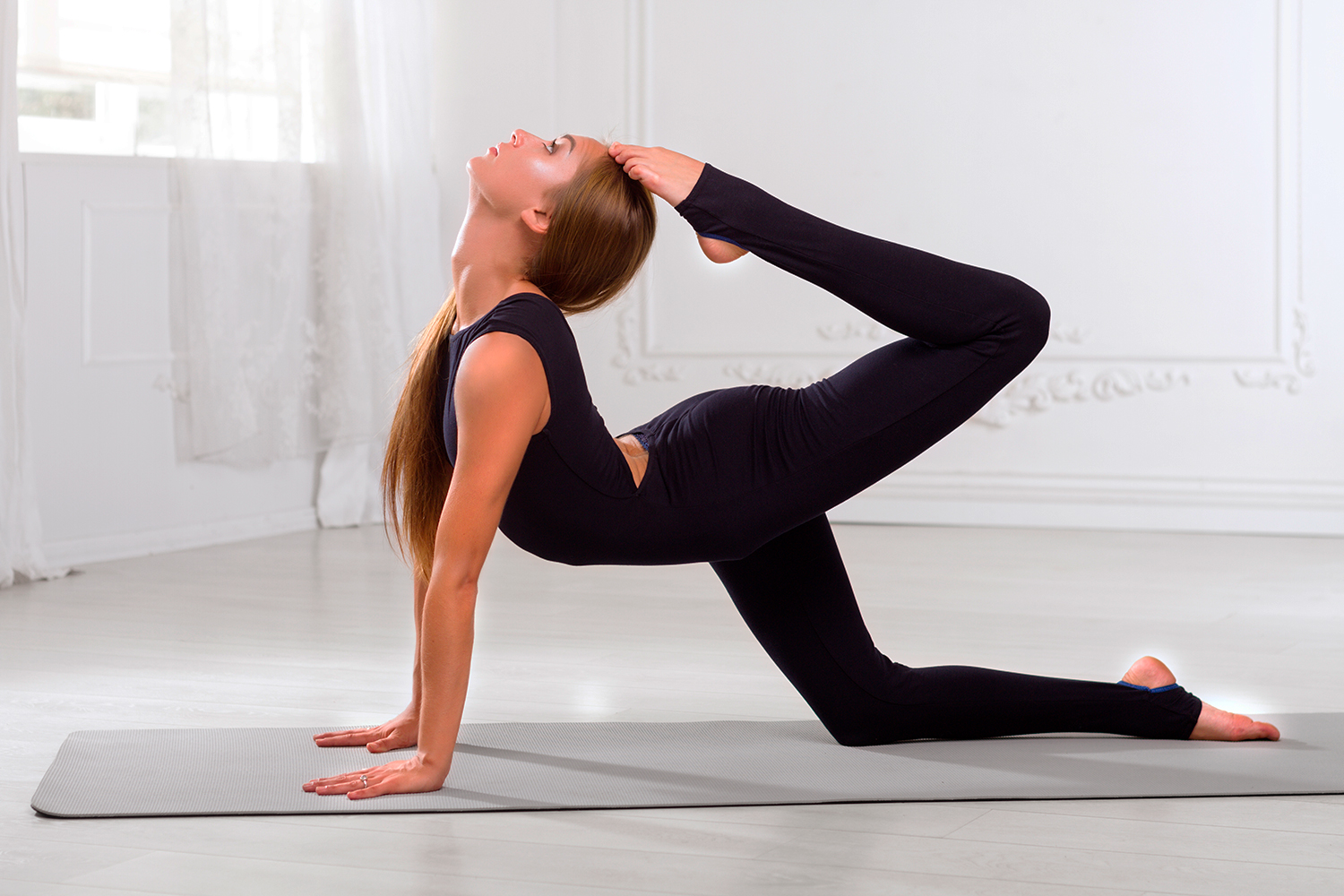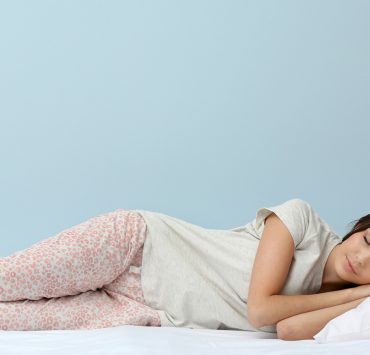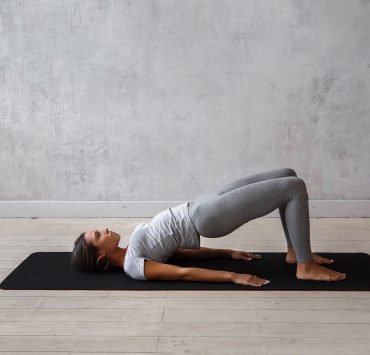
Rose graduated with a degree in Anthropology, which takes her…
Yoga is often regarded as a lifelong spiritual practice, which it is. However, for many people yoga can also be a remedy for specific health ailments. Many people come to yoga seeking cures for aches and pains, and develop their practice from there. There is nothing wrong with targeting your yoga practice to heal your body’s unique pains. One common complaint that leads people to yoga is pain in the neck or shoulders. Pain in this location is common, yet it can still be debilitating and affect quality of life. However, through the practice of yoga, including targeting yoga poses for neck and shoulder pain, a pain-free life is possible.
Why You Might Have Neck And Shoulder Pain

There are many reasons you might have neck and should pain, and most of them are related to the fast-paced, high-stress Western lifestyle. One example is ‘computer neck,’ causing pain in the shoulders and neck. This is an increasing phenomenon across the world and occurs due to people sticking their necks out and slouching their posture as they look at phones and computers. Likewise, most computers and desks are not ergonomically designed, which can lead to slouching and forward-jutting of the head. Anyone who works on a computer or at a desk job may have job-related neck and shoulder pain.
Yoga teaches us to cure what need not be endured and endure what cannot be cured. B.K.S. Iyengar
Perhaps the most common reason behind neck and shoulder pain is more emotional than physical, however. When a person is stressed, tense, insecure, or anxious they tend to collect these emotions in their shoulders. This comes from a subconscious desire to make the body smaller and less noticeable. Similarly, by hunching the shoulders forward, this protects and hides the Anahata (heart) chakra. By doing so, the person’s heart and emotions are closed off from perceived danger. This can lead to unhealthy defense mechanisms, a closed off emotional spirit, and the tell-tale neck and shoulder pain.
Dangers Of Neck And Shoulder Pain In Yoga
Neck and shoulder pain can be intense and enduring throughout daily life. They also impact yoga practice and can make some poses downright dangerous. Many yoga poses require an open heart and back, and neck and shoulder pain can be inhibiting. A specific example is Sarvangasana, or shoulder stand. In the full expression of this pose, the body weight rests across the base of the neck, shoulders, and upper arms. If attempted with tight and painful neck and shoulders, this pose can cause permanent damage due to misalignment. As you attempt yoga poses to alieve neck and shoulder pain, be mindful of your own body and spirit’s limitations. Practice Aparigraha, or non-attachment to the outcome of a pose. Bring your awareness inward and ask what is healing for you in that moment.
Uttanasana – Standing Forward Bend Pose

One of the staple poses of both Sun Salutation A and B, Uttanasana, or Standing Forward Bend, is an ideal pose for those with neck and shoulder pain. It is a good pose to start out with as it aligns the back without putting pressure on the joints.
How to practice Uttanasana: From Tadasana, standing, at the top of your mat, inhale and lift your arms. Exhale and bend forward, letting your arms hang down, and your hands land wherever they land on the mat. Keep your lower body strong and stable, and let your upper body hang loosely. For those with neck and shoulder pain, remember to release your head and neck. Many people tend to hold their head up in this pose. Instead let your head hang down so the crown of your head is reaching toward the mat. Nod your head ‘yes’ and ‘no’ and feel how this realigns the neck and shoulders. You can also clasp opposite elbows and sway side to side.
Adho Mukha Svanasana – Downward Facing Dog Pose

Adho Mukha Svanasana, or Downward Dog, is another staple pose of the Sun Salutations. However, unlike Uttanasana, it does require putting weight on the shoulder joints and arms. As such, it requires a certain amount of strength and flexibility before attempting. However, when practiced in proper alignment, this pose can be amazing for increasing strength in the shoulders and releasing tension in the neck.
How to practice Adho Mukha Svanasana: From plank pose, inhale and press back into Adho Mukha Svanasana. Try to cultivate an even weight between your upper and lower body. Don’t dump all your weight into your shoulders and arms. Instead, let your legs take on their equal share of weight. For those with neck and shoulder pain, be sure to press evenly through all four corners of you palms. Keep your arms engaged so as not to put undue pressure on your shoulders. Nod your head ‘yes’ and ‘no’ here, similar to Uttanasana, to align the neck and shoulders and alleviate pain.
Purvottanasana – Upward Facing Plank Pose

Much of shoulder and neck pain is associated with a tense and inflexible front body. Reverse the habitual pattern with front-openers such as Purvottanasana, or Upward Facing Plank.
How to practice Purvottanasana: Sit on your mat with your feet planted on the mat hips’ width apart, and your hands planted a few inches behind you, fingers pointing toward the front of the mat. When you are ready, inhale and lift your bottom up so you are in a reverse table top. Bring your shoulders together and down the back, away from the ears, as your open through the chest. Once this is comfortable, you may want to find full expression by walking your feet out until the legs are straight, and releasing your head back.
Bhujangasana – Cobra Pose

Bhujangasana, or Cobra Pose, is another foundational pose of the Sun Salutations and the vinyasa sequence. It is a wonderful heart opener and is particularly good for those with neck and shoulder pain, as it promotes flexibility in these joints.
How to practice Bhujangasana: From plank, lower down through chatturanga all the way onto your belly. From here, with hands planted alongside the chest and elbows bent toward the back of the room, lift the head and open the neck. Try not to squeeze your bottom or press through your hands in this pose. Instead, let the lift come from your back muscles. By strengthening your back and opening your heart you will relieve neck and shoulder pain.
Shalabasana – Locust Post Pose

Shalabasana – Locust PostPracticed in the finishing sequence, Shalabasana, or Locust Pose, is both a heart opener and a releaser of neck and shoulder pain, with multiple variations. Likewise, it builds strength along the spine which will support proper shoulder alignment and help reduce pain in the long term.
How to practice Shalabasana: Lie face down on the mat. Clasp your hands together at your tail, and draw your shoulder blades together and down your back. Keeping your feet together, on an inhale lift both ends of the body. As you hold here in a lifted state, remember to breathe deeply. Accept how your body shifts and moves with each breath. On each inhale, think of lifting more. On each exhale, think of releasing tension and pain.
Sukhasana Parivrtti – Easy Seated Twist Pose

Twisting poses can be especially good for neck and shoulder pain, as they both release the muscles, and can realign the vertebrae. There are many twisting poses, but a good one to start out with is Sukhasana Parivrtti, or Easy Seated Twist.
How to practice Sukhasana: From a cross-legged position, place your left hand on the outside of your right knee. Plant your right hand a few inches behind you. Inhale here for length, and exhale twist so you are turned and looking over your right shoulder. Do this poe on both sides, breathing into the twise.
Balasana – Child’s Pose

Balasana, or Child’s Pose, is one of the most restorative of yoga poses. It is a wonderful ‘resting’ pose, which can be returned to throughout the practice whenever you need a break. It is also a useful pose in its own right. In particular, it can relieve neck and shoulder pain because weigh is removed from these joints. By trying various variations, it is also adaptable to each individual’s needs.
How to practice Balasana: From all fours, sit back on the heels, and walk the hands all the way out in front. Untuck the toes and rest here with the forehead on the mat. Balasana can be practiced in multiple variations. Arms can be straight out in front, or back alongside the body. Additionally, knees can be together, or spread apart with the torso fall in between. You can also walk your hands side to side to get a stretch through the side shoulders and body in this pose.
Marjaryasana Bitilasana – Cat/Cow Pose

Some yoga poses are best when held for long periods of time, and others are more dynamic, such as Marjaryasana-Bitilasana, or Cat-Cow pose. Usually done during the beginning sequence to warm the body up, Cat and Cow pose can awaken the shoulders and neck by moving each vertebrae individually in a flowing motion.
How to practice Marjaryasana Bitilasana: From all fours, inhale and drop the belly and look up. This is ‘Cow’ pose. From here, exhale and round the spine until you are looking between the thights, bringing your belly button up toward the spine. This is called ‘Cat’ pose. Continue a cycle of Cat-Cow, matching it to your breath.
Uttana Shishosana – Extended Puppy Pose

Uttana Shishosana is more commonly referred to as Puppy Pose, and is as playful as the name implies. It is commonly practiced during the finishing sequence once the body is warmed up. Relax and breath into the pose to promote healing and alignment in the shoulders and neck.
How to practice Uttana Shishosana: From a position on all fours, walk the hands out in front as far as they will go, palms flat on the mat. Keep the knees planted and the sits bones reaching toward the ceiling. Let the chest sink toward the mat, and feel your front body opening whilst your shoulders and neck relax.
Savasana – Corpse Pose with props to open the chest

Savasana, or corpse pose, is one of the most traditional and universally practiced restorative yoga pose. It is taught and practiced as the final pose of the finishing sequence. It can be a wonderful pose to release neck and shoulder pain, particularly when practiced with props.
How to practice Savasana: Practiced at the end of a yoga practice, lie down flat on your back on your mat, palms open to the ceiling. Bring your shoulder blades together and down the back to open the chest and promote proper alignment. Chin should be slightly in toward the throat in order to lengthen the back of the neck. Breathe here and empty the mind. Hold the pose for a minimum of five minutes, preferably more. To use props for neck and shoulder pain, consider lying on a soft yet firm bolster. This can be placed either length-wise down the mat, or across the mat. Both versions will help open the neck and shoulders.
Conclusion

Painful neck and shoulders cannot be cured purely through yoga poses. As you begin your journey to release pain in your neck and shoulders, also be mindful of your habits that may be contributing to neck and shoulder pain. How can you adjust your lifestyle or adapt your habits to support your neck and shoulders? Remind yourself throughout the day to release your shoulders. You may be surprised how often you are subconsciously lifting your shoulders up toward your ears in tension. Likewise, be conscious of the emotional reasons you may be experiencing neck and shoulder pain. No amount of yoga poses can heal the emotional stress that may be leading you to protect your Anahata (heart) chakra from the world. After reflecting on this, you may decide to deepen your yoga practice to meditation or the Yamas and Niyamas, and find that these may be even more effective in your healing process.
What's Your Reaction?
Rose graduated with a degree in Anthropology, which takes her understanding of basic human needs to a whole new level. Her intelligence and passion for healthy living is reflected in her written work.














